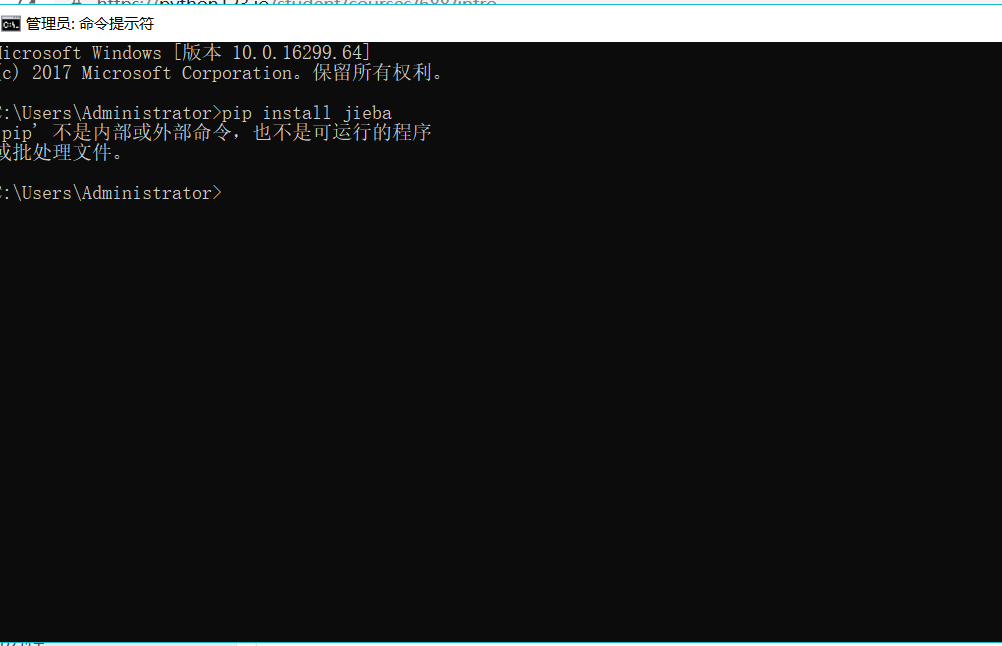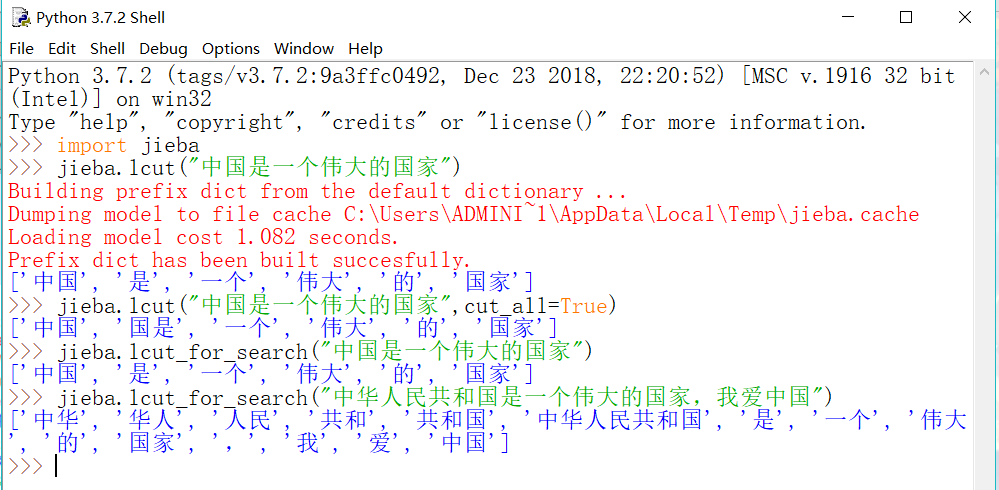运用jieba库分词
一、jieba库基本介绍
1、jieba库概述
jieba是优秀的中文分词第三方库
- 中文文本需要通过分词获得单个的词语
- jieba是优秀的中文分词第三方库,需要额外安装
- jieba库提供三种分词模式,最简单只需掌握一个函数
2、jieba分词的原理
Jieba分词依靠中文词库
- 利用一个中文词库,确定汉字之间的关联概率
- 汉字间概率大的组成词组,形成分词结果
- 除了分词,用户还可以添加自定义的词组
3、jieba库使用说明
(1)、jieba分词的三种模式
精确模式、全模式、搜索引擎模式
- 精确模式:把文本精确的切分开,不存在冗余单词
- 全模式:把文本中所有可能的词语都扫描出来,有冗余
- 搜索引擎模式:在精确模式基础上,对长词再次切分
(2)、jieba库常用函数

二、安装jieba库
点击电脑中的‘开始’,然后在搜索栏中输入‘cmd’,点击‘命令指示符’,出现界面后在输入‘pip install jieba’,刚开始的时候,我的电脑出现了这样的情况,安装不了。

后来在老师的帮助下,就安装成功了。而且在安装其他库的时候也不会再出现第一次的情况。

这样就安装成功啦~~~
三、jieba库的使用用例
1、分词

2、词云
这是我在网上找的词云的一个例子:
1 # 如果您需要使用此代码,os.chdir路经需要指定到txt文本所在路径 2 # 使用Zipin函数,需要txt有read()函数可以打开的正确的编码格式 3 # 使用Cipin函数需要安装jieba库 4 # 使用word cloud函数需要安装wordcloud与matplotlib库 5 import os 6 import codecs 7 import jieba 8 import pandas as pd 9 from wordcloud import WordCloud 10 from scipy.misc import imread 11 import matplotlib.pyplot as plt 12 os.chdir("/Users/Zhaohaibo/Desktop") 13 14 class Hlm(object): 15 16 # ————————————————————— 17 # Zipin(self, readdoc, writedoc) 18 # readdoc: 要读取的文件名 19 # writedoc:要写入的文件名 20 21 # output 22 # 字频前100,并写入writedoc 23 # ————————————————————— 24 def Zipin(self, readdoc, writedoc): 25 word_lst = [] 26 word_dict = {} 27 exclude_str = ",。!?、()【】<>《》=:+-*—“”…" 28 with open(readdoc,"r") as fileIn ,open(writedoc,'w') as fileOut: 29 30 # 添加每一个字到列表中 31 for line in fileIn: 32 for char in line: 33 word_lst.append(char) 34 35 # 用字典统计每个字出现的个数 36 for char in word_lst: 37 if char not in exclude_str: 38 if char.strip() not in word_dict: # strip去除各种空白 39 word_dict[char] = 1 40 else : 41 word_dict[char] += 1 42 43 # 排序x[1]是按字频排序,x[0]则是按字排序 44 lstWords = sorted(word_dict.items(), key=lambda x:x[1], reverse=True) 45 46 # 输出结果 (前100) 47 print ('字符 字频') 48 print ('=============') 49 for e in lstWords[:100]: 50 print ('%s %d' % e) 51 fileOut.write('%s, %d ' % e) 52 53 54 # ————————————————————— 55 # Cipin(self, doc) 56 # doc: 要读取的文件名 57 58 # return: 59 # 词频表(DataFrame格式) 60 # ————————————————————— 61 def Cipin(self, doc): 62 wdict = {} 63 f = open(doc,"r") 64 for line in f.readlines(): 65 words = jieba.cut(line) 66 for w in words: 67 if(w not in wdict): 68 wdict[w] = 1 69 else: 70 wdict[w] += 1 71 # 导入停用词表 72 stop = pd.read_csv('stoplist.txt', encoding = 'utf-8', sep = 'zhao', header = None,engine = 'python') #sep:分割符号(需要用一个确定不会出现在停用词表中的单词) 73 stop.columns = ['word'] 74 stop = [' '] + list(stop.word) #python读取时不会读取到空格。但空格依旧需要去除。所以加上空格; 读取后的stop是series的结构,需要转成列表 75 for i in range(len(stop)): 76 if(stop[i] in wdict): 77 wdict.pop(stop[i]) 78 79 ind = list(wdict.keys()) 80 val = list(wdict.values()) 81 ind = pd.Series(ind) 82 val = pd.Series(val) 83 data = pd.DataFrame() 84 data['词'] = ind 85 data['词频'] = val 86 return data 87 88 # ————————————————————— 89 # Ciyun(self, doc) 90 # doc: 要读取的文件名 91 92 # output: 93 # 词云图 94 # ————————————————————— 95 def Ciyun(self,doc): 96 g = open(doc,"r").read() 97 back_pic = imread("aixin.jpg") # 设置背景图片 98 wc = WordCloud( font_path='/System/Library/Fonts/STHeiti Medium.ttc',#设置字体 99 background_color="white", #背景颜色 100 max_words=2000,# 词云显示的最大词数 101 mask=back_pic,#设置背景图片 102 max_font_size=200, #字体最大值 103 random_state=42, 104 ).generate(g) 105 plt.figure(figsize=(64,32)) 106 plt.imshow(wc) 107 plt.axis('off') 108 plt.savefig("ciyun.jpg") 109 plt.show() 110 111 112 def main(self,readdoc): 113 # self.Zipin(readdoc,writedoc) 114 df = self.Cipin(readdoc) 115 #self.Ciyun(readdoc) 116 return df 117 118 119 if __name__ == '__main__': 120 hlm = Hlm() 121 hlm.Zipin("红楼梦.txt","红楼梦字频.txt") 122 df_hlm1 = hlm.main("红楼梦.txt") 123 --------------------- 124 作者:Iovebecky 125 来源:CSDN 126 原文:https://blog.csdn.net/zhaohaibo_/article/details/81902456 127 版权声明:本文为博主原创文章,转载请附上博文链接!
代码显示如下:

到这里就结束啦啦啦啦啦~~~~~~~